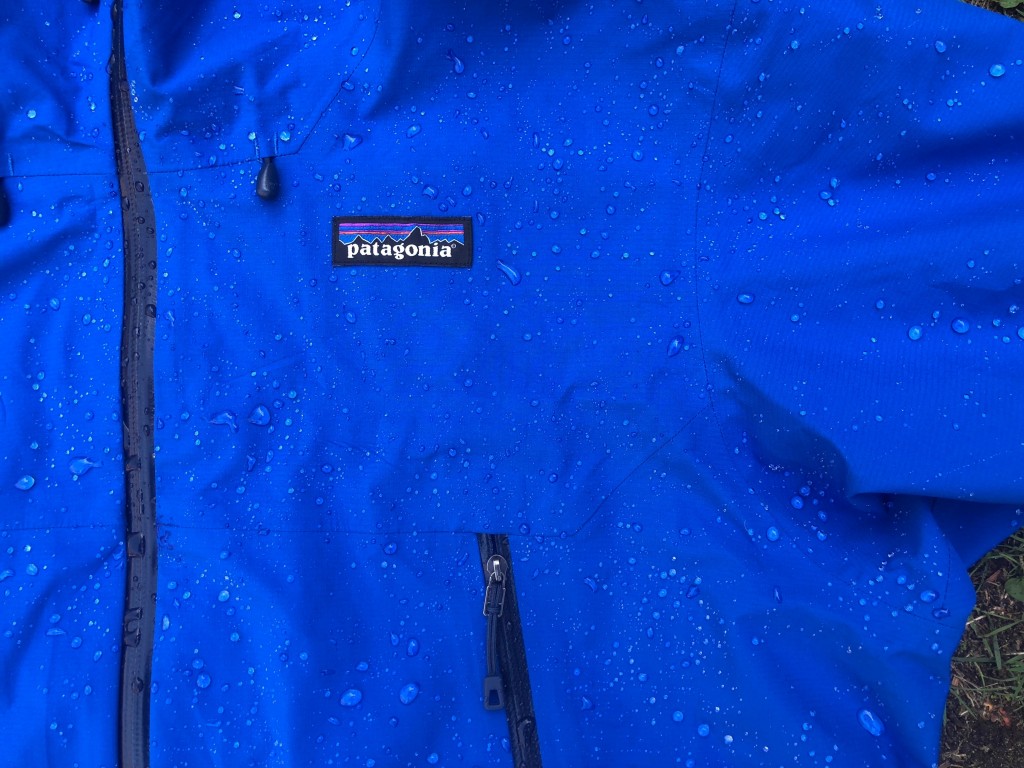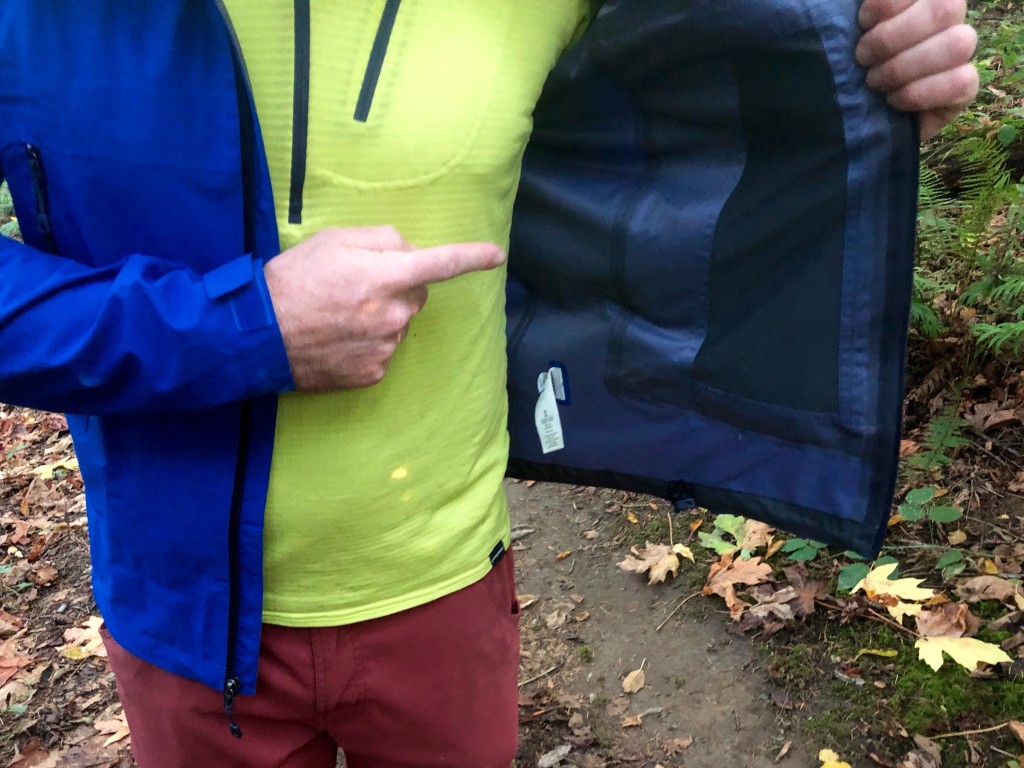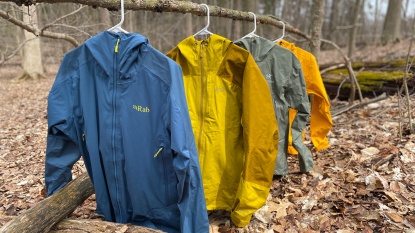Patagonia Cloud Ridge Review
Our Verdict
Our Analysis and Test Results
The Patagonia Cloud Ridge is a function-focused rain jacket that brings exceptional storm-worthiness to the table. While it is slightly heavier than some in our review, it's still plenty light for even the most weight-conscience adventures.
Performance Comparison
Water Resistance
The Cloud Ridge uses Patagonia's proprietary 3-layer H2No polyester membrane, which has been laminated to a 100% recycled polyester face fabric. The Cloud Rest is incredibly weather resistant, scoring toward the top of the tier.
While lighter models do exist in our review, we recommend bringing this model on your week-long backpacking trip if the forecast is particularly gloomy. The hood is enormous, yet cinches nicely, while the cuffs minimize the amount of wetness that came into our sleeves while performing tasks with our arms above our heads.
The Cloud Ridge is comparable in performance to the Outdoor Research Interstellar and the REI Drypoint GTX, the only other contenders to earn as high of scores in the water resistance metric, and is more stormworthy that many in the fleet.
Hood Design
Our testing team loved the ultra-adjustable hood which is designed to fit over most climbing or bike helmets (or your bare head). It cinches down nicely with one hand and loosens with two. It tightens in two ways; one around the back of your head more-or-less from ear-to-ear and the other in an upside down “U” over your forehead. This lets users of any size to adjust it to fit them and whatever headwear they might have - while maintaining top-notch peripheral vision.
Breathability & Venting
The Cloud Ridge offers good breathability and check-ins slightly above average compared to others in the review. It's more breathable than most coated membrane style models like the Marmot PreCip, The North Face Venture Jacket, or Patagonia Torrentshell. Compared to models in the $250 price range for this metric, it fared okay. Breathability and venting is the only category where the Cloud Ridge didn't particularly stand out with any notable characteristics.
This model offers no ventilation options, which was not a deal breaker for us. The Cloud Rest breathed adequately, as long as we minded our layering on our last rainy five day trip in Washington's North Cascade National Park, and did not have too many layers piled on. If it's pouring rain, or even after the rain has stopped, and you find yourself hiking up a wet, brushy, overgrown trail, opening any kind of vent is a quick way to invite moisture in.
Comfort and Mobility
This model's fabric offers the slightest bit of stretch which allows for forgiveness, though it's nowhere near as stretchy as the Rab Kinetic Plus. While it doesn't have much stretch as other models, mobility is built into the overall design. Generally speaking, we could lift our arms forward and straight in front of us without the sleeves pulling back from our wrists; with our hands above our heads, the pull back is minimal, about 3/4 of an inch.
The interior is made of polyester laminate, which tends to feel better against bare skin and less damp feeling than models with coated interior or nylon linings. While we thought this model offered a high level of comfort, it didn't compare to the Rab Kinetic Plus.
Pocket Design
This jacket was designed with practicality and outdoor driven purpose rather than to appeal to the masses. Few features demonstrate a motivated outdoor design more than a hip belt, and harness-friendly pockets, and the Cloud Ridge's are appreciated. While casual users might find them slightly on the high side, their placement ensures a higher level of comfort for hiking, backpacking, climbing, backcountry skiing, or any other activity where the user is required to wear a pack or climbing harness. We love the pockets.
Weight
The Cloud Ridge tips the scales at 14 ounces, making it one of the heavier models in our review. However, while it is only a few ounces heavier than others, it certainly brings plenty of advantages in durability and versatility for what is literally 1-3 ounces of weight penalty. Compared to its most direct competition, it simply isn't much heavier; for example, consider the Arc'teryx Zeta SL (11 ounces), or the REI Drypoint GTX (10.5 ounces).
Durability
Durability is a key to versatility and is one of the Cloud Ridge's greatest attributes. It's light enough to take backpacking, hiking, or climbing, but tough enough for downhill skiing or ski touring. The Outdoor Research Foray, Arc'teryx Zeta SL, and Marmot Minimalist offer up similar durability and are some of the toughest competitors on the block.
Packed Size
This model is slightly less compressible than average; while it's certainly packable enough for backpacking or mountaineering, a number of direct competitors pack down 10%, or a touch more, smaller. To help compress smaller, the Cloud Ridge comes with a separate stuff sack that does a solid job of compressing the jacket. It also has a sewn-in clip-in point to make it easier to hang off a harness.
Value
At $250, this jacket isn't cheap; it's one of the most expensive models and uses a proprietary fabric. While H2NO is Patagonia's proprietary waterproof fabric, it's not like polyester membranes are a tried and true technology. This model is slightly spendier than many, and a handful of competitors scored higher (at similar or lower prices).
Conclusion
The perfect jacket for someone who wants a rain shell to use for a variety of applications, the Patagonia Cloud Ridge is equally at home in any number of rainy day activities, from soggy, week-long backpacking trips to storm day skiing at the resort. While it might not be the best at any one thing, it does pretty darn well at everything; from ice climbing to day hiking, this model does it all and does it well. It's a tad overkill for folks looking for a lightweight just in case style jacket for hiking, climbing, or trail running; however, for folks expecting to be in the wetness for the long haul, this model should undoubtedly be on your radar.
















